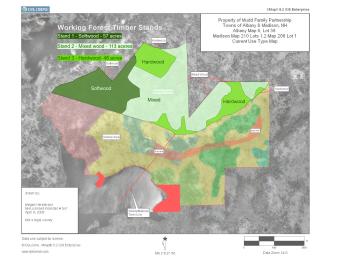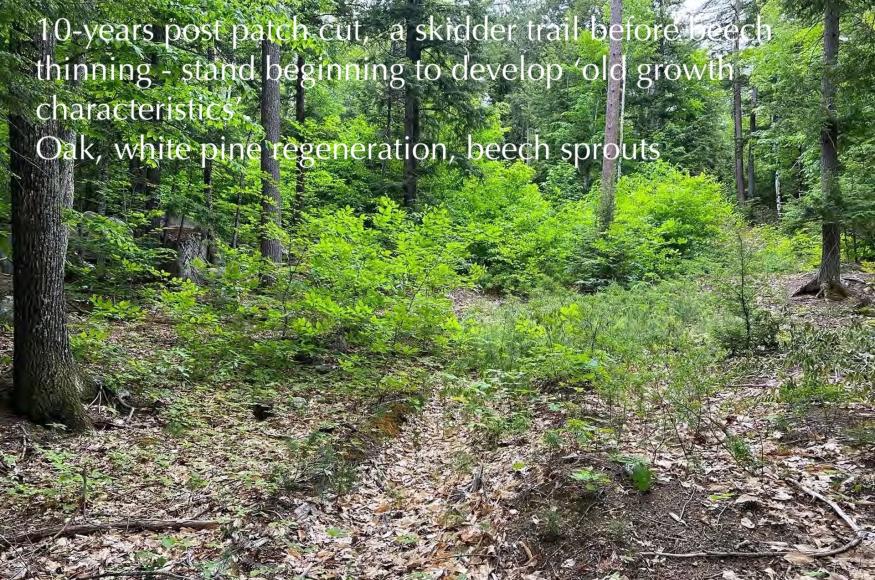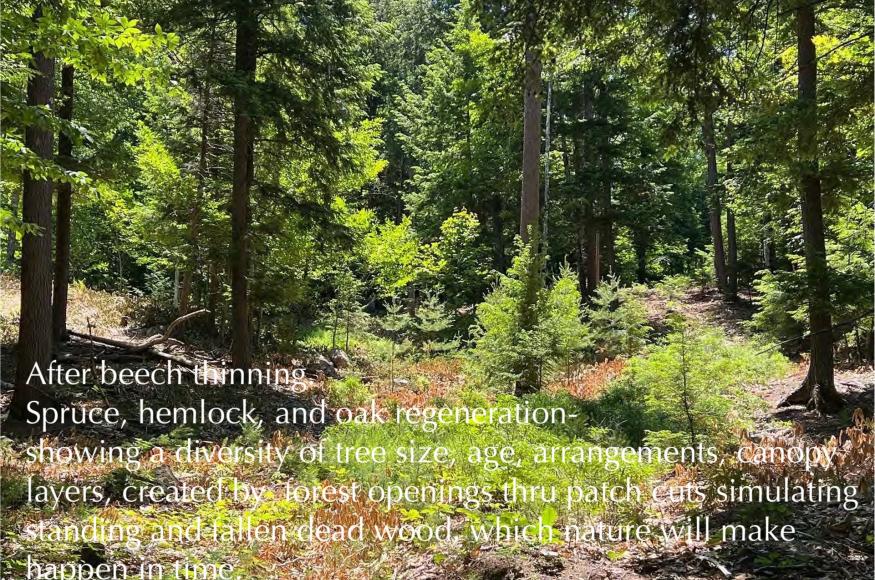Project Area
 The Mudd Working Forest is a 201-acre managed mixed-hardwood forest which is part of a 565-acre property under a conservation easement with The Nature Conservancy since 2018. The conservation easement includes a 364-acre "forever wild" area that preserves the shoreline and highlands around Whitton Pond, wetland areas southeast of the cliffs sloping towards the Madison Cedar Swamp, and several unique ecosystems, exemplary plant communities, and endangered species identified in the 2011 inventory (see the Ecological Features under “Project Documents”).
The Mudd Working Forest is a 201-acre managed mixed-hardwood forest which is part of a 565-acre property under a conservation easement with The Nature Conservancy since 2018. The conservation easement includes a 364-acre "forever wild" area that preserves the shoreline and highlands around Whitton Pond, wetland areas southeast of the cliffs sloping towards the Madison Cedar Swamp, and several unique ecosystems, exemplary plant communities, and endangered species identified in the 2011 inventory (see the Ecological Features under “Project Documents”).This Working Forest, actively managed for 13 years, comprises 227 acres on the north facing slopes of Whitton Ledge between 1200 and 400 feet in elevation. The forest is relatively homogenous mix of hemlock, beech, red oak, white and red pine. Between 2011 and 2013, two commercial harvests were conducted in Stand 1 (46-acre hardwood) and Stand 2 (113-acre mixed hardwood) totaling 159 acres, with the goal of promoting forest health. Stand 3 (57-acre softwood) was not part of these initial harvests. These harvests produced a net income to the partnership, which substantially paid the costs of creating the conservation easement signed in 2018. The initial harvest was whole-tree and the second harvest was cut-to-length to eliminate the need for large skidder trails and landing.
In this process, the family was introduced to and received valuable management input from the staff of The Nature Conservancy, NH Fish and Game, NH Natural Resources, and USDA - Natural Resources Conservation Services (NRCS). NRCS grants have funded interventions important to the management of the working forest including: Construction of a 3500-foot-long forest trail which created permanent access to the core of working forest for maintenance activities, three rounds of timber stand improvement (TSI), primarily to control beech, planting of 1000 mostly native trees species to increase diversity and provide edible forest products, and songbird monitoring across the entire property.
The current management plan builds on past management and refocuses on increasing the resilience of the Working Forest to face the challenges of climate change. Specific interventions planned for 2024 include assessing survival from 2013 plantings, designating future legacy trees, planting edible tree species in the meadow area, and restoring waterbars on the forest road.
Management Goals
Increase carbon storage (150 years)
- Enhance old-growth characteristics on the property by designating legacy trees ( >20”dbh, 12-20/acre), and promoting standing dead wood ( 8-12 trees/acre) and downed dead wood (6-9 trees/acre).
- Contribute carbon stored in harvested wood products by conducting periodic harvest of non-legacy trees sold for construction timber, supporting local logging, milling, and manufacturing industries (every 15-20 years).
Increase forest species diversity by introducing future climate-adapted native species while maintaining the health of the current forest (30 years)
- Increase oak (white, chestnut, and black) and hardwood (hickory, cherry) diversity through planting and natural regeneration.
- Maintain the health of species currently on site including red oak, white and red pine, hemlock, birch, and understory species.
- Reduce ‘invasive’ beech sprouting to reduce competition and promote regeneration of desired native species.
Add native and non-native species that can produce edible products for both wildlife and humans and can also provide economic benefits (30 years)
- Increase the vigor of sugar maple trees already on site.
- Plant edible trees including pine species (Korean, Swiss), disease-resistant chestnut hybrids (Collosal, Layeroka, and Brouche de Betizac), black walnut, and edible understory species including filbert (hazelnut), pawpaw, persimmon, and aronia.
Manage forest for key songbird and threatened plant species
- Maintaining dappled shade around population of Isotria medeoloides (orchid species).
- Monitor other songbird populations and integrate monitoring results to inform future management to promote key songbird habitat.
Conduct early identification and subsequent control of invasive species that could outcompete native and endangered species on the property (Ongoing)
- Use early detection and rapid response to control invasive species.
Climate Change Impacts
For this project, the most important anticipated climate change impacts include:
Forest vegetation in the region may face increased risk of moisture deficit and drought during the growing season and interact with other stressors such as spongy moth outbreaks to impact forest health.
Warmer temperatures and altered precipitation in the region will interact to change soil moisture patterns throughout the year, with the potential for both wetter and drier conditions depending on the location (e.g., slope, aspect) and season.
Conditions affecting tree regeneration and recruitment will change in the region due in part to increases in deer herbivory and invasive species establishment and spread. This will cause shifts to future forest composition.
Certain insect pests and pathogens will increase in occurrence or become more damaging in the region (e.g., spongy moth, EAB).
Intense precipitation events, windstorms, and ice storms will continue to become more frequent in the region.
Habitat will become more suitable in the region for some southern species.
Many invasive plants will increase in extent or abundance in the region.
Challenges and Opportunities
Climate change will present challenges and opportunities for accomplishing the management objectives of this project, including:
Challenges
Variable soil moisture conditions may make it more difficult to establish introduced edible forest species.
Though no serious pest or invasive species issues are currenting affecting the property, there is a risk of spreading pests and invasives with a warming climate that may increase risk of tree mortality and cause regeneration issues.
Higher elevation communities on site are vulnerable to damage from ice storms making it harder to maintain species diversity and the live aboveground carbon pool at these sites.
Sensitive species (i.e., Isotria) is especially sensitive to prolonged drought conditions.
Sprouting beech following harvest potentially limits regeneration of diverse species.
Opportunities
Warmer temperatures may facilitate new habitat for more southern-adapted tree species including those with edible products.
The northeast-facing, 5-15% grade slope and deep soils enhance water retention can buffer impacts from increased drought.
More frequent extreme disturbance events may naturally enhance old forest characteristics by increasing the amount of standing and downed deadwood.
Adaptation Actions
Project participants used the Adaptation Workbook to develop several adaptation actions for this project, including:
Area/Topic
Approach
Tactics
Forest ecosystems
Use patch cuts, non-commercial thinning, and forest stand improvement to improve forest health.
Threatened species
1.1 Reduce impacts to soils and nutrient cycling.
1.2. Maintain or restore hydrology.
4.3. Establish artificial reserves for at-risk and displaced species.
1.2. Maintain or restore hydrology.
4.3. Establish artificial reserves for at-risk and displaced species.
To protect Isotria (orchid species), maintain overstory to maintain dappled shade, hydrologic, and soil moisture conditions.
Delineate 2 to 3-acre buffer area around threatened species.
Old forest characteristics
5.1. Promote diverse age classes.
5.2. Maintain and restore diversity of native species.
5.3. Retain biological legacies.
5.2. Maintain and restore diversity of native species.
5.3. Retain biological legacies.
Designate legacy trees.
Promote more diverse structure (especially midstory and understory).
Focus on regeneration using small gap openings, by judicious removal of harvestable timber and suppressed, poor form trees.
Assisted migration
Maintain tree and herbaceous species diversity throughout by promoting unique species and planting future climate-adapted species, building off of 2012 planting of white, black, chestnut oak, and hickory.
Future-adapted edible tree species and forest farm
Promote trees planting in 2013 including 50 American chestnuts, 50 black walnut, 50 Chinese chestnuts , and 400 sugar maple, 20 black gum, viburnum species, dogwood species, and mountain ash.
Convert 1-acre landing into tree nursery to cultivate additional climate-adapted tree species (e.g., persimmon, pawpaw, 3 hybrid chestnut species, 40 chestnuts, and hazelnut).
Monitoring
Project participants identified several monitoring items that could help inform future management, including:
Conduct an inventory of songbird populations over entire 600-acre property, comparing natural and managed areas using using Merlin ID app.
Track change in Isotria (orchid species) population size every 5 years.
Measure old forest structural characteristics (abundance of snags, dead wood, and legacy trees greater than 20in DBH) in plots based on Tin Mountain protocol and GPS tag legacy trees locations.
Measure oak and hickory survival from 2013 planting and seedling survival of future planting efforts every 10 years; tag GPS points of survivors.
Monitor regeneration success of red spruce, oak, red maple, and other hardwood species (number of trees above browse level at 10 years post-planting).
Track invasive species presence/absence.
Monitor beech prevalence pre- and post- beech control treatment.
Project Documents
2023 song bird Report.pdf
(470.96 KB)
Ecological_features.pdf
(118.1 KB)


